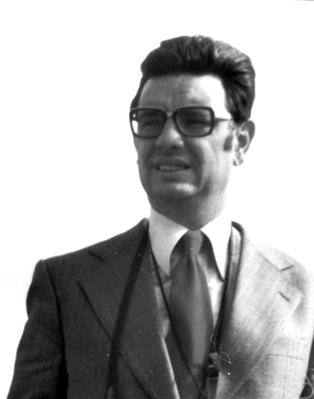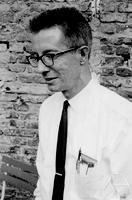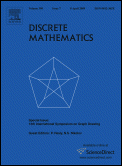Related Research Articles
Combinatorics is an area of mathematics primarily concerned with counting, both as a means and an end in obtaining results, and certain properties of finite structures. It is closely related to many other areas of mathematics and has many applications ranging from logic to statistical physics and from evolutionary biology to computer science.

Discrete mathematics is the study of mathematical structures that can be considered "discrete" rather than "continuous". Objects studied in discrete mathematics include integers, graphs, and statements in logic. By contrast, discrete mathematics excludes topics in "continuous mathematics" such as real numbers, calculus or Euclidean geometry. Discrete objects can often be enumerated by integers; more formally, discrete mathematics has been characterized as the branch of mathematics dealing with countable sets. However, there is no exact definition of the term "discrete mathematics".
Combinatorics is a branch of mathematics concerning the study of finite or countable discrete structures.

Discrete geometry and combinatorial geometry are branches of geometry that study combinatorial properties and constructive methods of discrete geometric objects. Most questions in discrete geometry involve finite or discrete sets of basic geometric objects, such as points, lines, planes, circles, spheres, polygons, and so forth. The subject focuses on the combinatorial properties of these objects, such as how they intersect one another, or how they may be arranged to cover a larger object.

Béla Bollobás FRS is a Hungarian-born British mathematician who has worked in various areas of mathematics, including functional analysis, combinatorics, graph theory, and percolation. He was strongly influenced by Paul Erdős since the age of 14.
The Fulkerson Prize for outstanding papers in the area of discrete mathematics is sponsored jointly by the Mathematical Optimization Society (MOS) and the American Mathematical Society (AMS). Up to three awards of $1,500 each are presented at each (triennial) International Symposium of the MOS. Originally, the prizes were paid out of a memorial fund administered by the AMS that was established by friends of the late Delbert Ray Fulkerson to encourage mathematical excellence in the fields of research exemplified by his work. The prizes are now funded by an endowment administered by MPS.

The chromatic polynomial is a graph polynomial studied in algebraic graph theory, a branch of mathematics. It counts the number of graph colorings as a function of the number of colors and was originally defined by George David Birkhoff to study the four color problem. It was generalised to the Tutte polynomial by Hassler Whitney and W. T. Tutte, linking it to the Potts model of statistical physics.

Algebraic graph theory is a branch of mathematics in which algebraic methods are applied to problems about graphs. This is in contrast to geometric, combinatoric, or algorithmic approaches. There are three main branches of algebraic graph theory, involving the use of linear algebra, the use of group theory, and the study of graph invariants.

Herbert Saul Wilf was a mathematician, specializing in combinatorics and graph theory. He was the Thomas A. Scott Professor of Mathematics in Combinatorial Analysis and Computing at the University of Pennsylvania. He wrote numerous books and research papers. Together with Neil Calkin he founded The Electronic Journal of Combinatorics in 1994 and was its editor-in-chief until 2001.

The Tutte polynomial, also called the dichromate or the Tutte–Whitney polynomial, is a graph polynomial. It is a polynomial in two variables which plays an important role in graph theory. It is defined for every undirected graph and contains information about how the graph is connected. It is denoted by .

In the mathematical field of graph theory, a distance-transitive graph is a graph such that, given any two vertices v and w at any distance i, and any other two vertices x and y at the same distance, there is an automorphism of the graph that carries v to x and w to y. Distance-transitive graphs were first defined in 1971 by Norman L. Biggs and D. H. Smith.

Jacobus Hendricus ("Jack") van Lint was a Dutch mathematician, professor at the Eindhoven University of Technology, of which he was rector magnificus from 1991 till 1996.
Ronald Cedric Read was a British mathematician, latterly a professor emeritus of mathematics at the University of Waterloo, Canada. He published many books and papers, primarily on enumeration of graphs, graph isomorphism, chromatic polynomials, and particularly, the use of computers in graph-theoretical research. A majority of his later work was done in Waterloo. Read received his Ph.D. (1959) in graph theory from the University of London.

Herbert John Ryser was a professor of mathematics, widely regarded as one of the major figures in combinatorics in the 20th century. He is the namesake of the Bruck–Ryser–Chowla theorem, Ryser's formula for the computation of the permanent of a matrix, and Ryser's conjecture.

Discrete Mathematics is a biweekly peer-reviewed scientific journal in the broad area of discrete mathematics, combinatorics, graph theory, and their applications. It was established in 1971 and is published by North-Holland Publishing Company. It publishes both short notes, full length contributions, as well as survey articles. In addition, the journal publishes a number of special issues each year dedicated to a particular topic. Although originally it published articles in French and German, it now allows only English language articles. The editor-in-chief is Douglas West.
Combinatorial physics or physical combinatorics is the area of interaction between physics and combinatorics.
Mathematics is a broad subject that is commonly divided in many areas that may be defined by their objects of study, by the used methods, or by both. For example, analytic number theory is a subarea of number theory devoted to the use of methods of analysis for the study of natural numbers.

David Ronald Wood is a Professor in the School of Mathematics at Monash University in Melbourne, Australia. His research area is discrete mathematics and theoretical computer science, especially structural graph theory, extremal graph theory, geometric graph theory, graph colouring, graph drawing, and combinatorial geometry.
Combinatorics: The Rota Way is a mathematics textbook on algebraic combinatorics, based on the lectures and lecture notes of Gian-Carlo Rota in his courses at the Massachusetts Institute of Technology. It was put into book form by Joseph P. S. Kung and Catherine Yan, two of Rota's students, and published in 2009 by the Cambridge University Press in their Cambridge Mathematical Library book series, listing Kung, Rota, and Yan as its authors. The Basic Library List Committee of the Mathematical Association of America has suggested its inclusion in undergraduate mathematics libraries.
References
- ↑ Norman L. Biggs at DBLP Bibliography Server .
- ↑ "Norman Linstead Biggs". UK: London School of Economics . Retrieved 29 April 2013.
- ↑ Biggs, Norman L. (2002). Discrete Mathematics (Second ed.).
- ↑ "Algebraic Graph Theory". UK: Cambridge Mathematical Library . Retrieved 15 April 2014.
- ↑ "Personal Details". UK: London School of Economics . Retrieved 15 April 2014.
- ↑ Biggs, Norman (2013). "Thomas Harriot". BSHM Bulletin: Journal of the British Society for the History of Mathematics. 28 (2): 66–74. doi:10.1080/17498430.2013.721331. S2CID 53586313.
- ↑ Biggs, Norman L. (25 June 1997). "Chip-Firing and the Critical Group of a Graph" (PDF). Journal of Algebraic Combinatorics: 25–45. Retrieved 10 May 2014.
- ↑ wikidot. "Chip-firing references" . Retrieved 19 May 2014.
- ↑ Wilf, Herbert S. (1975). "Review of Algebraic graph theory by Norman Biggs and Combinatorial theory seminar by Jacobus H. van Lint" (PDF). Bull. Amer. Math. Soc. 81 (3): 536–538. doi: 10.1090/s0002-9904-1975-13731-1 .
- ↑ Kantor, William M. (1981). "Review of Permutation groups and combinatorial structures by N. L. Biggs and A. T. White" (PDF). Bull. Amer. Math. Soc. (N.S.). 5 (2): 197–201. doi: 10.1090/s0273-0979-1981-14944-2 .
- ↑ "Contributions to Mathematics". UK: London School of Economics . Retrieved 15 April 2014.